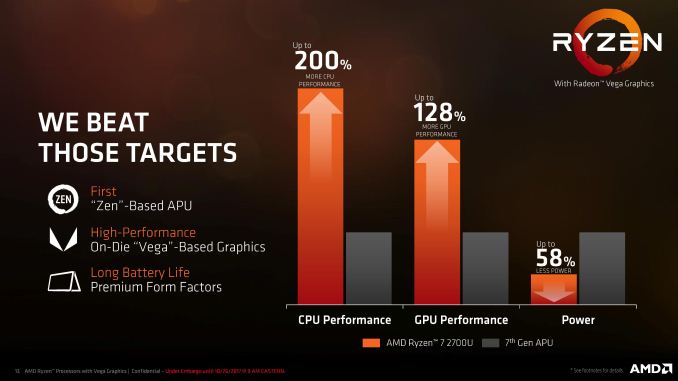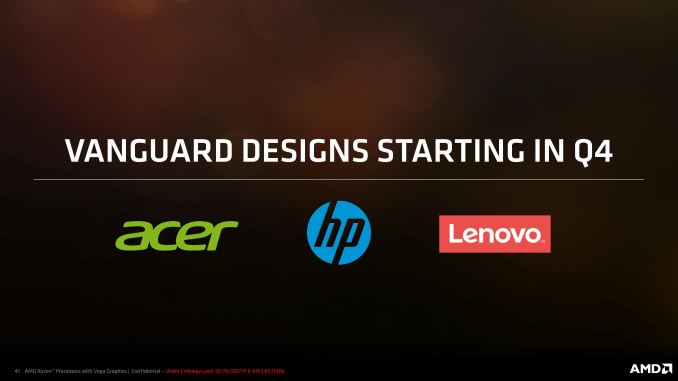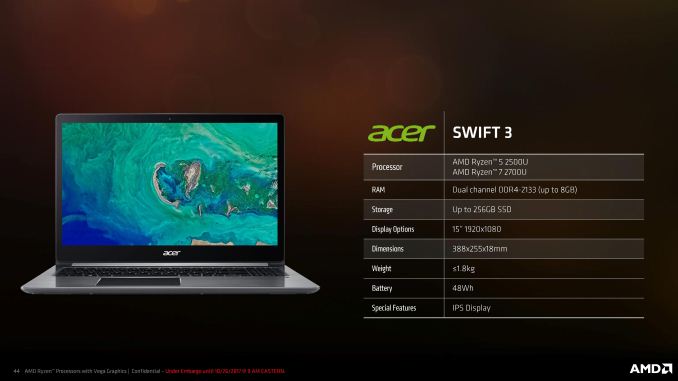Ryzen Mobile is Launched: AMD APUs for Laptops, with Vega and Updated Zen
by Ian Cutress on October 26, 2017 9:00 AM ESTAMD Ryzen Mobile: Zen 1.5
During our pre-briefings on Ryzen Mobile, it was asked why the two new APUs were using the 2000-series numbers, and not the 1000-series numbers like the desktop parts. It was assumed by the press that the first generation of Ryzen would all be under the 1000-series, including the mobile parts. The response given by Kevin Lensing, AMD’s Corporate VP of the Client Business Unit, was that so many of the design ideas that AMD wanted to put into the original desktop Ryzen (but couldn’t due to time) eventually ended up in Ryzen Mobile, such as the updated precision boost. While there are no architectural changes to Zen to warrant a next-generation microarchitecture name, this version of Ryzen’s periphery (i.e. the power) was more in-line with an original vision and had to be presented as such. This is why we have Ryzen 7 2700U, rather than a Ryzen 7 1700U. He would not comment if the true next generation Ryzen desktop naming would still be the 2000 series, or if we would go straight to 3000. Who knows, it might alternate.
The state of Zen aside, AMD’s return to high-performance computing with the Zen core was naturally going to trickle down into the notebook space. The question everyone asked is if such a high-power, high-performance core was going to make it in such a small power envelope: especially when you add some big graphics core next to it. In our desktop Ryzen reviews, we saw per-core power go as low as 8W per core, and AMD’s Vega was power hungry – promising to put four cores and some graphics into a single piece of silicon with a 15W TDP sounded harder than an uphill task, almost Sisyphean in nature. AMD has approached that by taking new methods to its power topology, how it manages that power, and found a combination of frequencies and performance that tally up to that 15W mark. They have also worked closely with the first three OEMs that are launching systems today to ensure a good user experience.
For performance, Ryzen Mobile has four cores with multithreading, with frequencies up to 3.8 GHz. This should give the mobile processor enough grunt under the hood in the 15W envelope to cater for a significant number of demanding workloads. GPU performance is also up, with AMD also hoping to push the hardware into a number of gaming-focused devices with FreeSync panels in the new few months. AMD is also touting significant power reductions during high-load tasks, leading to a 270% performance per watt improvement. More impressive is the steps taken towards how the processor manages power between cores and the GPU: a very complex implementation hopefully leading to a better power profile and 15-30% better battery life than previous generations for common use cases.
For the launch, AMD has partnered with HP, Acer and Lenovo for systems to go on shelves. As I am currently writing this, only HP provided any information about their upcoming systems and we’re likely to scramble when the other press releases come out. None of the three designs are ultimate eye-catching flagships, but rather approaching that middle-range $600-$1000 notebook territory with 13.3 inch 4K displays, up to 1TB SSDs, 48-55Wh batteries, and a device or two that can flip into a tablet. When we played briefly with the Acer unit in our pre-briefing, there was no lag – a user would be hard-pressed to immediately see a difference to a comparative Intel system.
Ultimately AMD has several very hard tasks ahead of it for Ryzen Mobile. Firstly it has to re-educate the sales teams at brick and mortar stores like Best Buy, who have only ever seen AMD has the low-cost budget option. If they still think the same way when Ryzen Mobile comes to town, they won’t be recommending them.
Second, they have to educate the public – after years of miserable user experiences leading to negative feedback loops, AMD has to convince these users that it is worth looking at AMD-powered devices again and there isn’t some sort of catch. Part of this solution will be in how well AMD integrates itself into the OEM sampling strategy for reviews, and if any reviewers are going to get devices this time around.
Third, AMD is several steps behind Intel in its marketing message: while Intel is trying to explain new ways to use the hardware (such as the failed ‘PC Does Whaaat?’ campaign almost a couple of years ago to the day), AMD is on the ‘I’m here too, and I’m just as good’ message. Back when we analyzed the Carrizo user experience, one thing we pointed out is that with most Intel flagships, most users do not even know what processor is inside – to these customers, saying ‘I’m just as good’ might give the impression ‘well what was wrong before?’. It might take AMD a round of flagships and XPS 13 or Zenbook Infinity-type designs to get the attention on their side of the discussion.
We have reached out to all three of the main OEMs who have Ryzen Mobile systems being announced today, but only one responded in time. This doesn’t bode well for any sampling, but we’re sitting here with a megaphone until we get one. Stay Tuned.
As part of this launch, AMD also discussed its progress towards its 25x20 goal, and AMD actually provided some data on how they are calculating this. We analyzed what AMD still has to do in a separate article, and you can read about it here:
http://www.anandtech.com/show/11965/amds-progress-on-its-25x20-goal-the-task-ahead














140 Comments
View All Comments
xemone - Thursday, October 26, 2017 - link
This is impressive and I'm glad to see AMD chips that can finally compete with Intel in the low TDP range. I am however, disappointed LPDDR4 compatibility isn't included in the initial parts.But these are only the first two and there are more to come, so I'm hopeful we'll see chips that support power-sipping memory. Any 15W TDP chip intended for the the ultrathin mobile market should at least allow for LP-DRAM. Let's not forget Intel has opened up Thunderbolt 3 and made it royalty-free. Adding these two technologies to AMDs Infinity Fabric "interconnect" onboard Raven Ridge would allow manufacturers to build sleeker devices. Board space is at a serious premium and that often why its hard to find low power AMD chips in these premium thin and lights.
Things are about to change!
sonichedgehog360@yahoo.com - Thursday, October 26, 2017 - link
“If we look at processors from Intel that are 4C/8T, like the 35W Core i7-7700T, this scores 777 in our testing, which kind of drives away from AMD’s point here. AMD succeeds in touting that it has ‘desktop-class performance’ in a small power package, attempting to redefine its status as high performance. Part of me thinks at this level, it could be said that all the mobile processors in this range have ‘desktop-class performance’, so this is a case of AMD now catching up to the competition.“You just said that in Cinebench R15, AMD’s Ryzen 7 2700U achieved 707 at 15W and compare it to a 35W Intel product that achieved 777. But you call this catching up; I would call that blowing past the competition! That score is nearly double the performance per watt, considering that you just compared AMD’s product with 15W TDP with an Intel product with a 35W TDP.
sonichedgehog360@yahoo.com - Thursday, October 26, 2017 - link
Looking more closely, a 15W Ryzen 7 2700U appears to fall right in line with an Intel Skull Canyon NUC’s 45W Intel Core i7-6700HQ in CPU performance and slightly outperforms it in GPU performance. Per the official AnandTech review, the Skull Canyon NUC got a Cinebench R15 ST/MT score of 148.24/711.04. Per NotebookCheck, its Iris Pro Graphics 580 achieves a score of 3510 in 3DMark 11 - Performance.SaturnusDK - Thursday, October 26, 2017 - link
I was similarly perplexed by the wording used here. How is more than double the performance per watt "catching up". The examples have the i7-7700T score 22.2 points per watt while the R7 2700U completely annihilates that by 47.1 point per watt. Seems to me that it is Intel that has a lot of catching up to do.sonichedgehog360@yahoo.com - Thursday, October 26, 2017 - link
It could be a combination of years of Intel having a lion’s share of the media mindshare (before Ryzen, for the longest time, the fact of the matter was that Intel was far and away the superior architecture) combined with the fact that there may have been very limited time given between receipt date and embargo time, giving way to more errors cropping up in a highly rushed journalism process.extide - Friday, October 27, 2017 - link
Yeah, but that 35W part could sustain that performance for a much longer time, if not indefinitely. The 15W AMD part (and likewise 15W Intel parts) will throttle down a fair bit after sustained use. According to AMD the R7 2700U drops to ~550 on cinebench after a 5-min loop. (Last slide on page 3)SaturnusDK - Friday, October 27, 2017 - link
It's possible it could sustain it for longer. We don't know that though. And even 550 points is still a massive performance per watt advantage to the AMD part. 770 points at 35W is 22 points per watt while 550 points (sustained) at 15W is 36.67 points per watt. A whooping 66.7% performance per watt advantage.lilmoe - Thursday, October 26, 2017 - link
I probably missed this, but any word on bulk pricing in comparison with Intel U series?Other than that, I'm pretty damn sure the 14nm LPP will shine at the 15w and lower power envelopes. This is where the power per watt comparisons matter for consumers. Same should be applicable to mobile Vega. I wonder if pairing the APU with a discreet mobile Vega part would have any advantages over an Intel/nVidia pair. Hopefully it would have better harmony and better switching drivers.
I would also love to see benchmarks emphasising latency vs Intel speed shift. I just hate to admit Intel might have an advantage there.
Too early to tell, but boy am I excited since what feels like ages.
Kamen75 - Thursday, October 26, 2017 - link
Samsung's 14nm LPP process being leased by GF just doesn't do Ryzen and Vega much justice on high performance desktop parts. Given 14nm LPP's smartphone SoC heritage it sure does let these low power AMD designs shine though. I'm also anticipating great things from IBM's 7nm process so long as it isn't delayed for an extra year. Bring on the 4.5 - 6 watt fanless APU's.I too am excited for the first time in years.
lilmoe - Thursday, October 26, 2017 - link
Fingers crossed for 6 or even 8 cores Zen2 and 14-16 CUs at 7nm, with higher max clocks for ST. HBM would be the icing on the cake. Throw a dGPU with twice or thrice the CUs and put your hand in my pocket and help yourself to my wallet AMD.